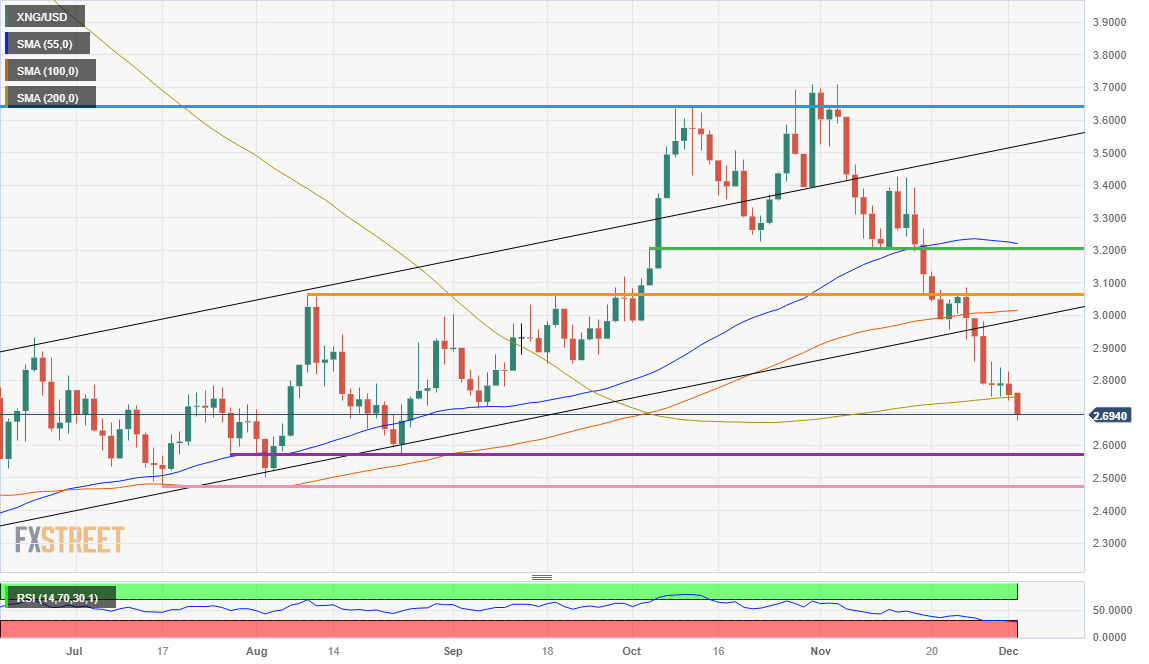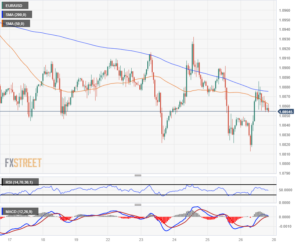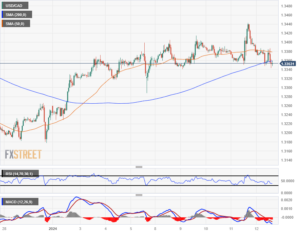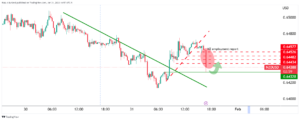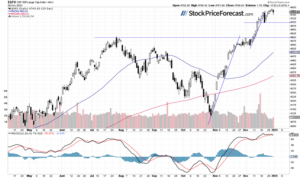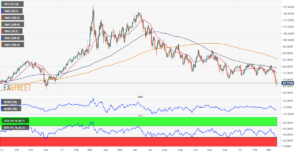- Natural Gas prices could return to $3 as cold season kicks in for Europe.
- Natural Gas prices have fallen throughout November.
- The US Dollar starts to turn after three weeks of continued weakness.
Natural Gas (XNG/USD) prices are sinking lower, despite soaring tensions in the Middle East. After an eventful weekend in the Gaza region, markets are heading into risk off with a flight to safe havens. Despite risk of a proxy war in the region, Gas prices are continuing their decline this Monday.
Meanwhile, the US Dollar (USD) is still trying to claw back against the weakness it registered in November. The Greenback depreciated for a third straight week on Friday evening at the close. Markets will be on the lookout for the US Jobs Report on Friday and the last US Federal Reserve Meeting of the year next week.
Natural Gas is trading at $2.65 per MMBtu at the time of writing.
Natural Gas market movers: Risk off for commodities
- Recent data reveales that the economic cost from both the Gaza war and Ukraine is now estimated higher as World War II, where higher energy prices are choking the economic growth of depending countries and regions on energy supply from conflict regions.
- The US has issued a warning that it is running out of budget to support Ukraine beyond December 2023.
- European Gas storage levels are seeing substantial drawdowns in stockpiles. The overall European Gas storage tracker was at 94.39% on Monday morning. Still, reserves in countries likeBelgium are at 87.44%, a ten-percentage-point decline in stockpiles since Friday.
- Austria might be facing issues at the EU council as the country is still seeing large amounts of Russian Gas flowing into its country. Austria is even forced to sell the Gas to neighbouring countries.
- COP28 President Sultan Al Jaber was condemned after a scandal leaked on phasing out fossil fuels. The Chief Executive Officer of the Abu Dhabi National Oil Company apparently used COP28 to have meetings to further strengthen and intensify Oil business deals.
Natural Gas Technical Analysis: Any moment now
Natural Gas might have reached the end in its continuous decline throughout November. With European gas storages starting to see substantial drawdowns after just three days of negative temperatures, the question will be if these reserves are big enough to face several days in a row of freezing cold. Adding the technical angle, the Relative Strength Index (RSI) trades in oversold territory, signalling that a pickup in demand might be due.
Meanwhile, pressure is building again in Gaza with Israeli troops advancing on several fronts, further escalating the situation. Adding this to the cold front in Europe, Natural Gas could edge up to $3.0 as the level to watch. Just above, the 100-day Simple Moving Average (SMA) at $3.01 could throw a brief spanner in the works. Once bulls have dealt with a break above this 100-day SMA, look for $3.06 and $3.20 as next profit levels on the upside.
With the support of the 200-day SMA gone now, a further decline will target two intermediary levels on the downside. the fIrst one is the purple line near $2.57, which triggered a bounce on August 24. In case that fails, the low of the summer near $2.48 might be strong enough to catch any falling knives, with the RSI by then severely in oversold regime.
XNG/USD (Daily Chart)
Natural Gas FAQs
Supply and demand dynamics are a key factor influencing Natural Gas prices, and are themselves influenced by global economic growth, industrial activity, population growth, production levels, and inventories. The weather impacts Natural Gas prices because more Gas is used during cold winters and hot summers for heating and cooling. Competition from other energy sources impacts prices as consumers may switch to cheaper sources. Geopolitical events are factors as exemplified by the war in Ukraine. Government policies relating to extraction, transportation, and environmental issues also impact prices.
The main economic release influencing Natural Gas prices is the weekly inventory bulletin from the Energy Information Administration (EIA), a US government agency that produces US gas market data. The EIA Gas bulletin usually comes out on Thursday at 14:30 GMT, a day after the EIA publishes its weekly Oil bulletin. Economic data from large consumers of Natural Gas can impact supply and demand, the largest of which include China, Germany and Japan. Natural Gas is primarily priced and traded in US Dollars, thus economic releases impacting the US Dollar are also factors.
The US Dollar is the world’s reserve currency and most commodities, including Natural Gas are priced and traded on international markets in US Dollars. As such, the value of the US Dollar is a factor in the price of Natural Gas, because if the Dollar strengthens it means less Dollars are required to buy the same volume of Gas (the price falls), and vice versa if USD strengthens.
- SEO Powered Content & PR Distribution. Get Amplified Today.
- PlatoData.Network Vertical Generative Ai. Empower Yourself. Access Here.
- PlatoAiStream. Web3 Intelligence. Knowledge Amplified. Access Here.
- PlatoESG. Carbon, CleanTech, Energy, Environment, Solar, Waste Management. Access Here.
- PlatoHealth. Biotech and Clinical Trials Intelligence. Access Here.
- Source: https://www.fxstreet.com/news/natural-gas-price-looks-set-for-rebound-as-frost-grips-europe-202312041145
- :has
- :is
- :where
- $3
- $UP
- 01
- 06
- 14
- 20
- 2023
- 24
- 30
- 35%
- 40
- 65
- 87
- a
- above
- abu dhabi
- activity
- adding
- administration
- advancing
- After
- again
- against
- agency
- AL
- also
- amounts
- an
- analysis
- and
- Animate
- any
- ARE
- AS
- At
- AUGUST
- Austria
- average
- back
- BE
- because
- Beyond
- Big
- both
- Bounce
- Break
- budget
- Building
- bulletin
- Bulls
- business
- business deals
- buy
- by
- CAN
- case
- Catch
- Chart
- cheaper
- chief
- Chief Executive
- chief executive officer
- China
- Close
- cold
- comes
- Commodities
- company
- competition
- Condemned
- conflict
- Consumers
- content
- continued
- continuing
- continuous
- cop28
- Cost
- could
- Council
- countries
- country
- Currency
- daily
- data
- day
- Days
- Deals
- December
- Decline
- Demand
- Depending
- Despite
- Dhabi
- Dollar
- dollars
- downside
- due
- during
- dynamics
- East
- Economic
- Economic growth
- Edge
- EIA
- end
- ends
- energy
- energy prices
- enough
- environmental
- estimated
- EU
- Europe
- European
- European gas
- Even
- evening
- eventful
- events
- executive
- Executive Officer
- expanded
- extraction
- Face
- facing
- factor
- factors
- fails
- Fallen
- Falling
- Falls
- FAQ
- Federal
- federal reserve
- First
- flight
- Flowing
- For
- fossil
- fossil fuels
- Freezing
- Friday
- from
- front
- fuels
- further
- GAS
- gas prices
- geopolitical
- Germany
- Global
- Global Economic
- GMT
- gone
- Government
- Greenback
- Growth
- Have
- Heading
- higher
- HOT
- HTTPS
- if
- ii
- Impact
- impacting
- Impacts
- in
- include
- Including
- index
- industrial
- influenced
- influencing
- information
- intermediary
- International
- into
- inventory
- Israeli
- Issued
- issues
- IT
- ITS
- Japan
- Jobs
- jobs report
- just
- Key
- key factor
- Kicks
- knives
- large
- largest
- Last
- less
- Level
- levels
- Line
- Look
- Low
- lower
- Main
- Market
- Market Data
- Markets
- May..
- means
- meeting
- meetings
- Middle
- Middle East
- might
- module
- moment
- Monday
- more
- morning
- most
- Movers
- moving
- moving average
- National
- Natural
- Natural Gas
- Near
- negative
- next
- next week
- November
- now
- of
- off
- Officer
- Oil
- on
- once
- ONE
- Other
- out
- over
- overall
- per
- Pickup
- plato
- Plato Data Intelligence
- PlatoData
- policies
- population
- president
- pressure
- price
- Prices
- primarily
- produces
- Production
- Profit
- proxy
- Publishes
- question
- reached
- regime
- region
- regions
- registered
- relative
- relative strength index
- Relative Strength Index (RSI)
- release
- Releases
- report
- required
- Reserve
- Reserve Currency
- reserves
- return
- Risk
- ROW
- rsi
- running
- russian
- Russian gas
- safe
- same
- Scandal
- Season
- see
- seeing
- sell
- several
- severely
- Simple
- since
- situation
- Slides
- SMA
- soaring
- Sources
- Starting
- starts
- Still
- storage
- straight
- strength
- Strengthen
- Strengthens
- strong
- substantial
- such
- sultan
- summer
- supply
- Supply and Demand
- support
- Switch
- Target
- Technical
- Technical Analysis
- tensions
- territory
- that
- The
- The Weekly
- their
- themselves
- then
- These
- Third
- this
- three
- throughout
- thursday
- Thus
- time
- to
- traded
- trades
- Trading
- transportation
- triggered
- trying
- TURN
- two
- Ukraine
- Upside
- us
- US Dollar
- US Dollars
- US Federal
- us federal reserve
- us government
- US Jobs Report
- USD
- used
- usually
- value
- vice
- volume
- war
- War in Ukraine
- warning
- was
- Watch
- weakness
- Weather
- week
- weekend
- weekly
- Weeks
- which
- will
- with
- works
- world
- world’s
- writing
- year
- zephyrnet

